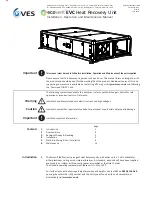Users Manual
13
Network Connectivity, -RN units
Gen 5 Iconyx are connected and controlled with RHAON II software via a normal Ethernet network. Standard Ethernet star topology is used with
off-the-shelf switches. Each Gen 5 Iconyx array is a node on the network and connects to the network switch via a home-run CAT5e or CAT6
Ethernet cable. The maximum cable run supported on copper Ethernet is 100 meters. Gen 5 -RN units may be controlled via Wi-Fi if a Wi-Fi access
point is connected to the network switch. The units do not have direct Wi-Fi connectivity on board, they must connect to the switch via copper.
Note that -RN units are connected and controlled using the AVDECC standard. This communication is all Layer 2; -RN units do not receive and do
not need an IP address.
Network connections are necessary only for initial setup and beamsteering. If the arrays are easily accessible, it’s common to set up a temporary
network for control during installation and not have a fixed network in place all the time.
For details on network setup, RHAON II and beamsteering, see the RHAON II manual.
Network Connectivity, -RD Dante units
Gen 5 Dante Iconyx are connected and controlled with RHAON II software and Dante audio is transmitted via a normal Ethernet network. Standard
Ethernet star topology is used with off-the-shelf switches. For Dante audio transport, Gigabit switches are recommended. You must disable EEE
or “Green Ethernet” functions in the switch. If you can’t disable EEE, use a different switch. RHAON II and Dante
share the same Ethernet network,
only one network connection is necessary.
Each Gen 5 Iconyx array is a node on the network and connects to the network switch via a home-run CAT5e or CAT6 Ethernet cable. The
maximum cable run supported on copper Ethernet is 100 meters. Gen 5 -RD units are available with a single-mode fiber optic input option that
can extend the working cable distance to 5 kilometers.
Important: Wi-Fi may not be used with Dante units.
Primary and Secondary Network Ports
Each -RD Iconyx has two network ports, primary and secondary. These ports can be configured as a two-port Gigabit switch, or for redundant
networking. As shipped, the ports are set as a two-port switch, allowing Iconyx -RD units to be “daisy-chained.” We recommend that this feature
be used sparingly, passing control and audio to a local subwoofer, for example. It would not be recommended to daisy chain units down a long
corridor as any failure would affect multiple arrays. Each daisy chain connection is a switch hop and may increase your network diameter and
increase latency.
The ports can be reconfigured for redundant network operation using Dante
Controller. In this case, a second, redundant network would be connected to
the secondary port. (This must be a complete, separate, redundant network.)
If the primary network fails, the unit will switch to the secondary network. This
switch over is normally instantaneous and silent. All Renkus-Heinz Dante units
are Dante Domain Manager compliant.
Dante Audio Routing
To select a Dante audio flow, in RHAON II, Source Select, select either Dante
Rx 1 or Dante Rx 2 as the main audio source, Figure 1. Then, in Dante
Controller, connect the flows from the Dante sources, Figure 2.
For more information about Dante audio networking and to download Dante
Controller go to
www.audinate.com.
For details on network setup, RHAON II and beamsteering, see the RHAON II
manual.
Figure 1
Figure 2


















